Enhancing CO2 Fixation and Wastewater Treatment Performance by Assembling MgFe-LDH on Chlorella pyrenoidosa
Abstract
1. Introduction
2. Materials and Methods
2.1. Preparation and Characterization of MgFe-LDH
2.2. Algal Strain Source and Co-Culture of MgFe-LDH and C. pyrenoidosa
2.3. Measurement of Pigment Content
2.4. Intracellular Oxidative Stress Activity in C. pyrenoidosa
2.5. Extraction and Three-Dimensional Fluorescence Analysis of Extracellular Polymeric Substances (EPS)
2.6. Analysis of Biogas Slurry Water Quality Indicators
3. Results and Discussion
3.1. Self-Assembly of MgFe-LDH and C. pyrenoidosa
3.2. The Effect of MgFe-LDH on the Growth and CO2 Fixation of C. pyrenoidosa
3.3. Enhancement of Biogas Slurry Purification by C. pyrenoidosa with MgFe-LDH and the Underlying Mechanism
4. Conclusions
Supplementary Materials
Author Contributions
Funding
Institutional Review Board Statement
Informed Consent Statement
Data Availability Statement
Conflicts of Interest
Abbreviations
| CCM | Carbon concentration mechanism |
| CA | Carbonic anhydrase |
| LDH | Layered double hydroxide |
| XRD | X-ray diffraction |
| PBS | phosphate-buffer solution |
| MDA | Malondialdehyde |
| SOD | Superoxide dismutase |
| ROS | Reactive oxygen species |
| Ex | Excitation wavelength |
| Em | Emission wavelength |
| EPS | Extracellular polymeric substances |
| 3D-EEM | Three-dimensional excitation-emission matrix |
| TN | Total nitrogen |
| TP | Total phosphorus |
| NH3-N | Ammonia nitrogen |
| COD | Chemical oxygen demand |
References
- Goswami, R.K.; Mehariya, S.; Karthikeyan, O.P.; Gupta, V.K.; Verma, P. Multifaceted Application of Microalgal Biomass Integrated with Carbon Dioxide Reduction and Wastewater Remediation: A Flexible Concept for Sustainable Environment. J. Clean. Prod. 2022, 339, 130654. [Google Scholar] [CrossRef]
- Nguyen, L.N.; Vu, M.T.; Vu, H.P.; Johir, M.A.H.; Labeeuw, L.; Ralph, P.J.; Mahlia, T.M.I.; Pandey, A.; Sirohi, R.; Nghiem, L.D. Microalgae-Based Carbon Capture and Utilization: A Critical Review on Current System Developments and Biomass Utilization. Crit. Rev. Environ. Sci. Technol. 2023, 53, 216–238. [Google Scholar] [CrossRef]
- Ramanna, L.; Ansari, F.A.; Rawat, I.; Bux, F. Microalgae-Driven Carbon Sequestration and Bio-Fertiliser: Steps towards a Sustainable Future. Chem. Eng. J. 2025, 519, 164892. [Google Scholar] [CrossRef]
- Zhang, Y.; Yin, Z.; Xie, J.; Zou, X.; Dai, Y.; He, D.; Li, J. Efficient Treatment of Actual Biogas Slurry by Chlorella Sorokiniana: Nutrient Recovery and Biomass Production. J. Water Process Eng. 2024, 66, 106007. [Google Scholar] [CrossRef]
- Xu, X.; Gu, X.; Wang, Z.; Shatner, W.; Wang, Z. Progress, Challenges and Solutions of Research on Photosynthetic Carbon Sequestration Efficiency of Microalgae. Renew. Sustain. Energy Rev. 2019, 110, 65–82. [Google Scholar] [CrossRef]
- Ma, J.; Cui, Y.; Sun, F.; Zhou, R.; Liu, F.; Cao, K.; Zhu, B.; Zhang, H.; Meng, C.; Chen, G.; et al. Strategies for Enhancing Microalgal Carbon Sequestration: A Review on Strain Development, Culture System Optimization, Parameter Control, and Metabolic Engineering. Bioresour. Technol. 2025, 435, 132868. [Google Scholar] [CrossRef]
- Li, J.; Tang, X.; Pan, K.; Zhu, B.; Li, Y.; Ma, X.; Zhao, Y. The Regulating Mechanisms of CO2 Fixation and Carbon Allocations of Two Chlorella sp. Strains in Response to High CO2 Levels. Chemosphere 2020, 247, 125814. [Google Scholar] [CrossRef]
- Hou, C.; Zhao, J.; Huang, B.; Zhou, X.; Zhang, Y. Microalgae-Based Technologies for Carbon Neutralization and Pollutant Remediation: A Comprehensive and Systematic Review. Resour. Conserv. Recycl. 2024, 202, 107323. [Google Scholar] [CrossRef]
- Tan, F.; Wang, Z.; Zhouyang, S.; Li, H.; Xie, Y.; Wang, Y.; Zheng, Y.; Li, Q. Nitrogen and Phosphorus Removal Coupled with Carbohydrate Production by Five Microalgae Cultures Cultivated in Biogas Slurry. Bioresour. Technol. 2016, 221, 385–393. [Google Scholar] [CrossRef]
- Wang, L.; Chen, L.; Wu, S. Microalgae Cultivation Using Screened Liquid Dairy Manure Applying Different Folds of Dilution: Nutrient Reduction Analysis with Emphasis on Phosphorus Removal. Appl. Biochem. Biotechnol. 2020, 192, 381–391. [Google Scholar] [CrossRef]
- Gil-Izquierdo, A.; Pedreño, M.A.; Montoro-García, S.; Tárraga-Martínez, M.; Iglesias, P.; Ferreres, F.; Barceló, D.; Núñez-Delicado, E.; Gabaldón, J.A. A Sustainable Approach by Using Microalgae to Minimize the Eutrophication Process of Mar Menor Lagoon. Sci. Total Environ. 2021, 758, 143613. [Google Scholar] [CrossRef]
- Qin, L.; Yin, Z.; Sun, Z.; Wu, Z.; Zhu, L.; Zhou, S. Valence-Variable Iron Biostimulation: Mechanisms Insights into Enhanced Microalgae Wastewater Treatment via Transcriptomics and Proteomics. Chem. Eng. J. 2025, 519, 165577. [Google Scholar] [CrossRef]
- Huang, H.; Zhong, S.; Wen, S.; Luo, C.; Long, T. Improving the Efficiency of Wastewater Treatment and Microalgae Production for Biofuels. Resour. Conserv. Recycl. 2022, 178, 106094. [Google Scholar] [CrossRef]
- Le Gouic, B.; Marec, H.; Pruvost, J.; Cornet, J.F. Investigation of Growth Limitation by CO2 Mass Transfer and Inorganic Carbon Source for the Microalga Chlorella Vulgaris in a Dedicated Photobioreactor. Chem. Eng. Sci. 2021, 233, 116388. [Google Scholar] [CrossRef]
- Hou, Y.; Han, T.; Wu, R.; Liu, Z.; Ma, Y.; Guo, Z.; Hao, N.; Wang, W.; Ji, X.; Zhu, Z.; et al. A Novel System Integrating Electrolysis and Ionic Membranes (EIMs) Enables Artificial Carbon Concentration and Alleviation of Metal Cation Stress in Microalgae Cultivation. Green Chem. 2023, 25, 7273–7282. [Google Scholar] [CrossRef]
- Arend, M.; Yuan, Y.; Ruiz-Sola, M.Á.; Omranian, N.; Nikoloski, Z.; Petroutsos, D. Widening the Landscape of Transcriptional Regulation of Green Algal Photoprotection. Nat. Commun. 2023, 14, 2687. [Google Scholar] [CrossRef]
- Dao, O.; Bertrand, M.; Alseekh, S.; Veillet, F.; Auroy, P.; Nguyen, P.-C.; Légeret, B.; Epting, V.; Morin, A.; Cuiné, S.; et al. The Green Algae CO2 Concentrating Mechanism and Photorespiration Jointly Operate during Acclimation to Low CO2. Nat. Commun. 2025, 16, 5296. [Google Scholar] [CrossRef]
- Singh, S.K.; Sundaram, S.; Sinha, S.; Rahman, M.A.; Kapur, S. Recent Advances in CO2 Uptake and Fixation Mechanism of Cyanobacteria and Microalgae. Crit. Rev. Environ. Sci. Technol. 2016, 46, 1297–1323. [Google Scholar] [CrossRef]
- Ugya, A.Y.; Sheng, Y.; Chen, H.; Wang, Q. Microalgal Bioengineering: A Futuristic Tool for Carbon Capture. Results Eng. 2024, 24, 102990. [Google Scholar] [CrossRef]
- Hu, J.; Wang, D.; Chen, H.; Wang, Q. Advances in Genetic Engineering in Improving Photosynthesis and Microalgal Productivity. Int. J. Mol. Sci. 2023, 24, 1898. [Google Scholar] [CrossRef]
- Li, M.-J.; Wang, R.-L.; Yang, Y.-W.; Chen, J.-X. Numerical and Experimental Analysis of Optimized Conical Flask Photobioreactor Structures to Improve Liquid–Gas Two-Phase Distribution and Microalgae Carbon Sequestration. Appl. Therm. Eng. 2020, 180, 115855. [Google Scholar] [CrossRef]
- Cheng, J.; Xu, J.; Ye, Q.; Lai, X.; Zhang, X.; Zhou, J. Strengthening Mass Transfer of Carbon Dioxide Microbubbles Dissolver in a Horizontal Tubular Photo-Bioreactor for Improving Microalgae Growth. Bioresour. Technol. 2019, 277, 11–17. [Google Scholar] [CrossRef]
- De Morais, M.G.; Vargas, B.P.; Da Silva Vaz, B.; Cardias, B.B.; Costa, J.A.V. Advances in the Synthesis and Applications of Nanomaterials to Increase CO2 Biofixation in Microalgal Cultivation. Clean. Techn Environ. Policy 2021, 25, 617–632. [Google Scholar] [CrossRef]
- Comitre, A.A.; Vaz, B.D.S.; Costa, J.A.V.; Morais, M.G.D. Renewal of Nanofibers in Chlorella Fusca Microalgae Cultivation to Increase CO2 Fixation. Bioresour. Technol. 2021, 321, 124452. [Google Scholar] [CrossRef]
- Yang, Y.-W.; Li, M.-J.; Hung, T.-C. Enhancing CO2 Dissolution and Inorganic Carbon Conversion by Metal–Organic Frameworks Improves Microalgal Growth and Carbon Fixation Efficiency. Bioresour. Technol. 2024, 407, 131113. [Google Scholar] [CrossRef] [PubMed]
- Komkhum, T.; Sema, T.; Rehman, Z.U.; In-na, P. Carbon Dioxide Removal from Triethanolamine Solution Using Living Microalgae-Loofah Biocomposites. Sci. Rep. 2025, 15, 7247. [Google Scholar] [CrossRef] [PubMed]
- Qiu, S.; Wu, Z.; Chen, Z.; Abbew, A.-W.; Li, J.; Ge, S. Microalgal Activity and Nutrient Uptake from Wastewater Enhanced by Nanoscale Zerovalent Iron: Performance and Molecular Mechanism. Environ. Sci. Technol. 2022, 56, 585–594. [Google Scholar] [CrossRef] [PubMed]
- Rehman, R.; Iqbal, J.; Ur Rehman, M.S.; Hamid, S.; Wang, Y.; Rasool, K.; Fazal, T. Algal-Biochar and Chlorella Vulgaris Microalgae: A Sustainable Approach for Textile Wastewater Treatment and Biodiesel Production. Biochar 2024, 6, 65. [Google Scholar] [CrossRef]
- Wang, X.; Hou, X.; Wang, Q.; Ge, W.; Guo, S. In Situ Fabrication of Flaky-like NiMn-Layered Double Hydroxides as Efficient Catalyst for Li-O2 Battery. J. Solid. State Electrochem. 2019, 23, 1121–1128. [Google Scholar] [CrossRef]
- Ye, H.; Liu, S.; Yu, D.; Zhou, X.; Qin, L.; Lai, C.; Qin, F.; Zhang, M.; Chen, W.; Chen, W.; et al. Regeneration Mechanism, Modification Strategy, and Environment Application of Layered Double Hydroxides: Insights Based on Memory Effect. Coord. Chem. Rev. 2022, 450, 214253. [Google Scholar] [CrossRef]
- Mohapatra, L.; Parida, K. A Review on the Recent Progress, Challenges and Perspective of Layered Double Hydroxides as Promising Photocatalysts. J. Mater. Chem. A 2016, 4, 10744–10766. [Google Scholar] [CrossRef]
- Budhysutanto, W.N.; Van Agterveld, D.; Schomaker, E.; Rossenaar, B.D.; Van Rosmalen, G.M.; Kramer, H.J.M. Chemical Composition and Interlayer Arrangement of Polytype 3R2 Mg–Al Layered Double Hydroxides. Appl. Clay Sci. 2011, 52, 374–380. [Google Scholar] [CrossRef]
- Sharma, A.; Kumari, S.; Sharma, S.; Singh, T.; Kumar, S.; Thakur, A.; Bhatia, S.K.; Sharma, A.K. Layered Double Hydroxides: An Insight into the Role of Hydrotalcite-Type Anionic Clays in Energy and Environmental Applications with Current Progress and Recent Prospects. Mater. Today Sustain. 2023, 22, 100399. [Google Scholar] [CrossRef]
- Tokudome, Y.; Fukui, M.; Iguchi, S.; Hasegawa, Y.; Teramura, K.; Tanaka, T.; Takemoto, M.; Katsura, R.; Takahashi, M. A nanoLDH Catalyst with High CO2 Adsorption Capability for Photo-Catalytic Reduction. J. Mater. Chem. A 2018, 6, 9684–9690. [Google Scholar] [CrossRef]
- Yang, Z.; Wei, J.; Zeng, G.; Zhang, H.; Tan, X.; Ma, C.; Li, X.; Li, Z.; Zhang, C. A Review on Strategies to LDH-Based Materials to Improve Adsorption Capacity and Photoreduction Efficiency for CO2. Coord. Chem. Rev. 2019, 386, 154–182. [Google Scholar] [CrossRef]
- Yong, Z.; Mata; Rodrigues, A.E. Adsorption of Carbon Dioxide onto Hydrotalcite-like Compounds (HTlcs) at High Temperatures. Ind. Eng. Chem. Res. 2001, 40, 204–209. [Google Scholar] [CrossRef]
- Iturbe-García, J.L.; Bonifacio Martínezs, J.; Granados Correa, F.; López-Muñoz, B.E. Behavior of a Hydrotalcite Type Material Obtained from MgAl Alloy for CO2 Adsorption. Appl. Clay Sci. 2019, 183, 105296. [Google Scholar] [CrossRef]
- Hanif, A.; Sun, M.; Shang, S.; Tian, Y.; Yip, A.C.K.; Ok, Y.S.; Yu, I.K.M.; Tsang, D.C.W.; Gu, Q.; Shang, J. Exfoliated Ni-Al LDH 2D Nanosheets for Intermediate Temperature CO2 Capture. J. Hazard. Mater. 2019, 374, 365–371. [Google Scholar] [CrossRef]
- Sakr, A.A.-E.; Zaki, T.; Elgabry, O.; Ebiad, M.A.; El-Sabagh, S.M.; Emara, M.M. Enhanced CO2 Capture from Methane-Stream Using MII -Al LDH Prepared by Microwave-Assisted Urea Hydrolysis. Adv. Powder Technol. 2021, 32, 4096–4109. [Google Scholar] [CrossRef]
- Hadj-Abdelkader, N.E.H.; Beltrao-Nunes, A.-P.; Belkhadem, F.; Benselka, N.; Roy, R.; Azzouz, A. New Insights in MgAl and MgFe-LDH Affinity towards Carbon Dioxide—Role of the Hydrophilic Character on CO2 Retention Strength. Appl. Clay Sci. 2020, 198, 105829. [Google Scholar] [CrossRef]
- Hu, T.; Gu, Z.; Williams, G.R.; Strimaite, M.; Zha, J.; Zhou, Z.; Zhang, X.; Tan, C.; Liang, R. Layered Double Hydroxide-Based Nanomaterials for Biomedical Applications. Chem. Soc. Rev. 2022, 51, 6126–6176. [Google Scholar] [CrossRef]
- Wang, L.; Ran, N.; Hu, T.; Cui, X.; Kang, Y.; Ge, M. Bioactive LDH Nanoplatforms for Cancer Therapy: Advances in Modulating Programmed Cell Death. Mater. Today Bio 2025, 34, 102139. [Google Scholar] [CrossRef]
- Sajid, M.; Sajid Jillani, S.M.; Baig, N.; Alhooshani, K. Layered Double Hydroxide-Modified Membranes for Water Treatment: Recent Advances and Prospects. Chemosphere 2022, 287, 132140. [Google Scholar] [CrossRef] [PubMed]
- Palmer, S.J.; Spratt, H.J.; Frost, R.L. Thermal Decomposition of Hydrotalcites with Variable Cationic Ratios. J. Therm. Anal. Calorim. 2009, 95, 123–129. [Google Scholar] [CrossRef]
- Lund, A.; Manohara, G.V.; Song, A.-Y.; Jablonka, K.M.; Ireland, C.P.; Cheah, L.A.; Smit, B.; Garcia, S.; Reimer, J.A. Characterization of Chemisorbed Species and Active Adsorption Sites in Mg–Al Mixed Metal Oxides for High-Temperature CO2 Capture. Chem. Mater. 2022, 34, 3893–3901. [Google Scholar] [CrossRef] [PubMed]
- Chen, X.; Zhang, C.; Tan, L.; Wang, J. Toxicity of Co Nanoparticles on Three Species of Marine Microalgae. Environ. Pollut. 2018, 236, 454–461. [Google Scholar] [CrossRef]
- Zamani, H. Effect of Co-Exposure of Multi-Wall Carbon Nanotubes and Cadmium on Microalga Dunaliella Salina. J. Appl. Phycol. 2023, 35, 661–671. [Google Scholar] [CrossRef]
- Liu, T.; Wang, Y.; Li, J.; Yu, Q.; Wang, X.; Gao, D.; Wang, F.; Cai, S.; Zeng, Y. Effects from Fe, P, Ca, Mg, Zn and Cu in Steel Slag on Growth and Metabolite Accumulation of Microalgae: A Review. Appl. Sci. 2021, 11, 6589. [Google Scholar] [CrossRef]
- Li, Y.; Xu, X.; Lei, B.; Zhuang, J.; Zhang, X.; Hu, C.; Cui, J.; Liu, Y. Magnesium-Nitrogen Co-Doped Carbon Dots Enhance Plant Growth through Multifunctional Regulation in Photosynthesis. Chem. Eng. J. 2021, 422, 130114. [Google Scholar] [CrossRef]
- Rana, M.S.; Prajapati, S.K. Resolving the Dilemma of Iron Bioavailability to Microalgae for Commercial Sustenance. Algal Res. 2021, 59, 102458. [Google Scholar] [CrossRef]
- Jeffers, T.L.; Purvine, S.O.; Nicora, C.D.; McCombs, R.; Upadhyaya, S.; Stroumza, A.; Whang, K.; Gallaher, S.D.; Dohnalkova, A.; Merchant, S.S.; et al. Iron Rescues Glucose-Mediated Photosynthesis Repression during Lipid Accumulation in the Green Alga Chromochloris Zofingiensis. Nat. Commun. 2024, 15, 6046. [Google Scholar] [CrossRef]
- Zhou, H.; Wang, J.; Xu, Z.; Wang, X.; Zhang, Z.; Lan, C.Q. Two-Step Cultivation of Neochloris Oleoabundans in a Novel Horizontal Thin-Layer Algal Reactor: Interplay of pH and Dissolved Inorganic Carbon. Biochem. Eng. J. 2024, 205, 109244. [Google Scholar] [CrossRef]
- Agbebi, T.V.; Ojo, E.O.; Watson, I.A. Towards Optimal Inorganic Carbon Delivery to Microalgae Culture. Algal Res. 2022, 67, 102841. [Google Scholar] [CrossRef]
- Sade, Z.; Hegyi, S.; Halevy, I. Equilibration Times of Dissolved Inorganic Carbon During pH Transitions. Front. Earth Sci. 2022, 9, 792858. [Google Scholar] [CrossRef]
- Wu, Q.; Li, S.; Wang, H.; Wang, W.; Gao, X.; Guan, X.; Zhang, Z.; Teng, Y.; Zhu, L. Construction of an Efficient Microalgal-Fungal Co-Cultivation System for Swine Wastewater Treatment: Nutrients Removal and Extracellular Polymeric Substances (EPS)-Mediated Aggregated Structure Formation. Chem. Eng. J. 2023, 476, 146690. [Google Scholar] [CrossRef]
- Xiao, R.; Zheng, Y. Overview of Microalgal Extracellular Polymeric Substances (EPS) and Their Applications. Biotechnol. Adv. 2016, 34, 1225–1244. [Google Scholar] [CrossRef] [PubMed]
- Sun, X.-M.; Ren, L.-J.; Ji, X.-J.; Huang, H. Enhancing Biomass and Lipid Accumulation in the Microalgae Schizochytrium sp. by Addition of Fulvic Acid and EDTA. AMB Expr. 2018, 8, 150. [Google Scholar] [CrossRef]
- Shi, W.; Zhang, G.; Li, F.; Feng, J.; Chen, X. Two-Step Adsorption Model for Pb Ion Accumulation at the Algae-Water Interface in the Presence of Fulvic Acid. Sci. Total Environ. 2020, 742, 140606. [Google Scholar] [CrossRef]
- Liu, X.; Ji, B.; Li, A. Enhancing Biolipid Production and Self-Flocculation of Chlorella Vulgaris by Extracellular Polymeric Substances from Granular Sludge with CO2 Addition: Microscopic Mechanism of Microalgae-Bacteria Symbiosis. Water Res. 2023, 236, 119960. [Google Scholar] [CrossRef] [PubMed]
- Hao, T.-B.; Zhang, Z.-H.; Hu, L.-L.; Liu, S.-F.; Mou, J.-H.; Yang, P.; Yuan, Z.; Zhang, Q.; Balamurugan, S.; Yang, W.-D.; et al. Dissolved Organic Matter-Mediated Metabolic Shifts in Chlorella Sorokiniana Enhanced Bioremediation of Multi-Ionic Stress. J. Hazard. Mater. 2025, 496, 139350. [Google Scholar] [CrossRef] [PubMed]
- Xia, Z.; Ng, H.Y.; Bae, S. Synergistic Microalgal-Bacterial Interactions Enhance Nitrogen Removal in Membrane-Aerated Biofilm Photoreactors Treating Aquaculture Wastewater under Salt Stress: Insights from Metagenomic Analysis. Water Res. 2025, 283, 123878. [Google Scholar] [CrossRef]
- Chen, W.; Westerhoff, P.; Leenheer, J.A.; Booksh, K. Fluorescence Excitation−Emission Matrix Regional Integration to Quantify Spectra for Dissolved Organic Matter. Environ. Sci. Technol. 2003, 37, 5701–5710. [Google Scholar] [CrossRef]
- Strotmann, U.J.; Eismann, F.; Hauth, B.; Bias, W.R. An Integrated Test Strategy for the Assessment of Anaerobic Biodegradability of Wastewaters. Chemosphere 1993, 26, 2241–2254. [Google Scholar] [CrossRef]
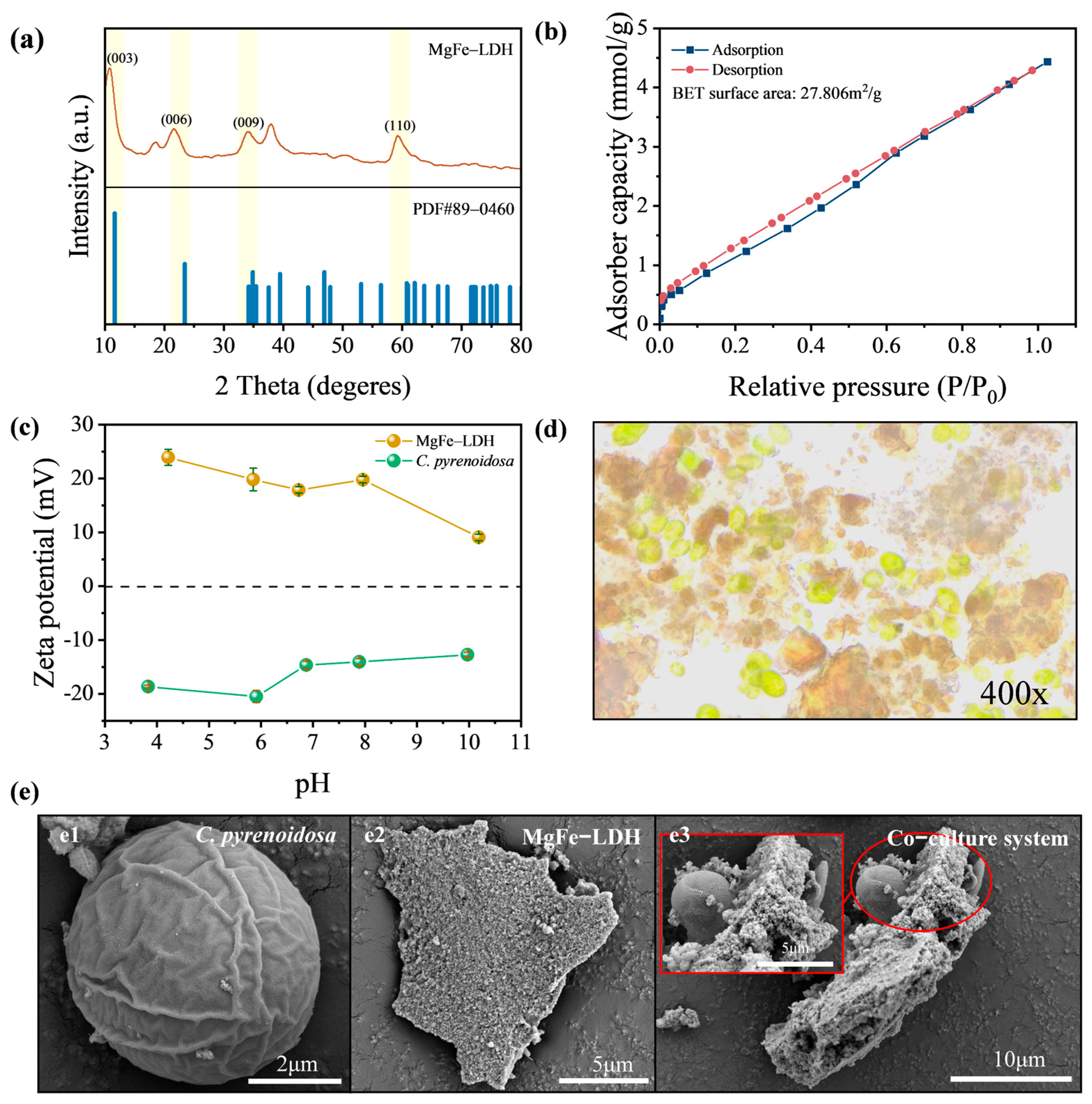
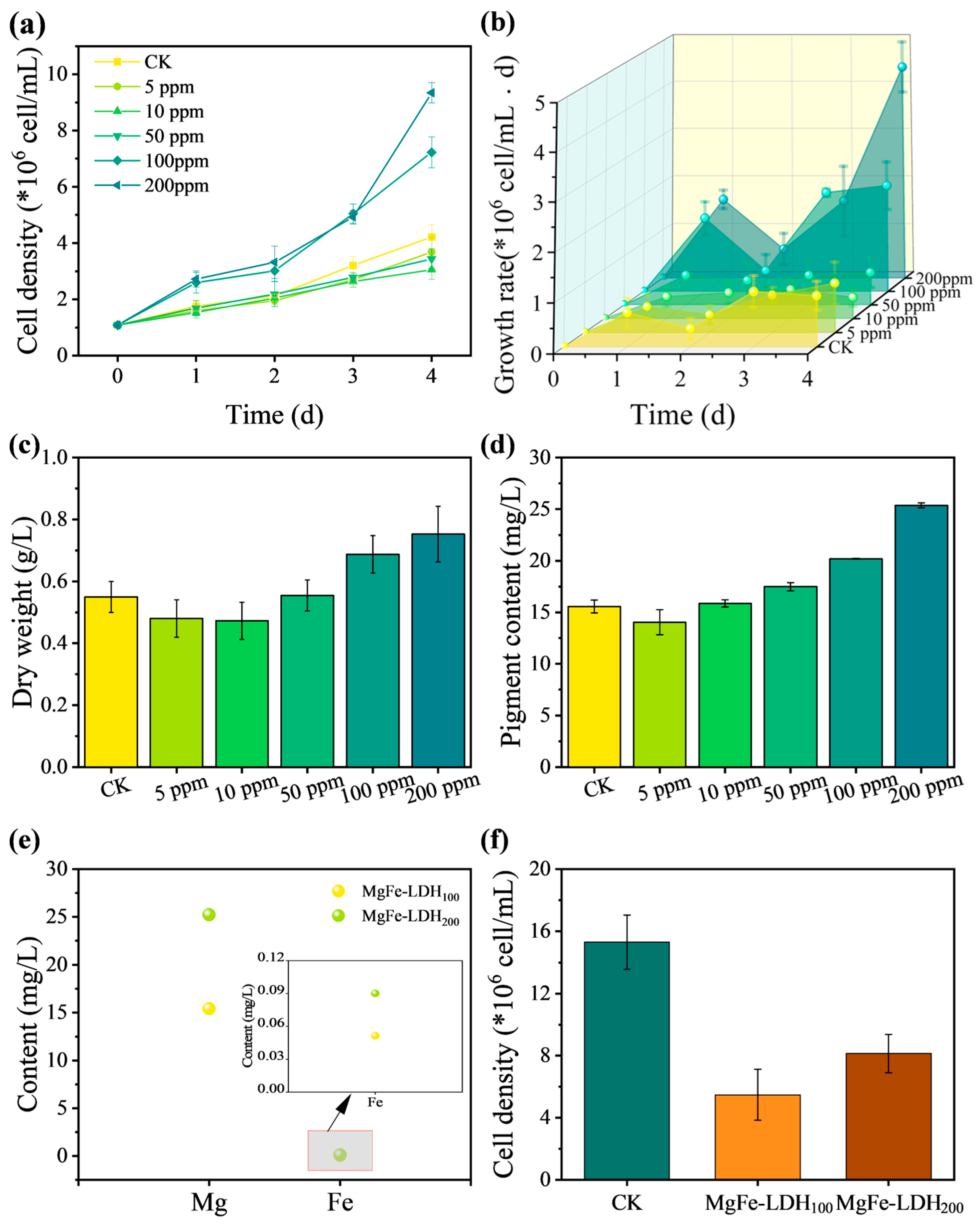
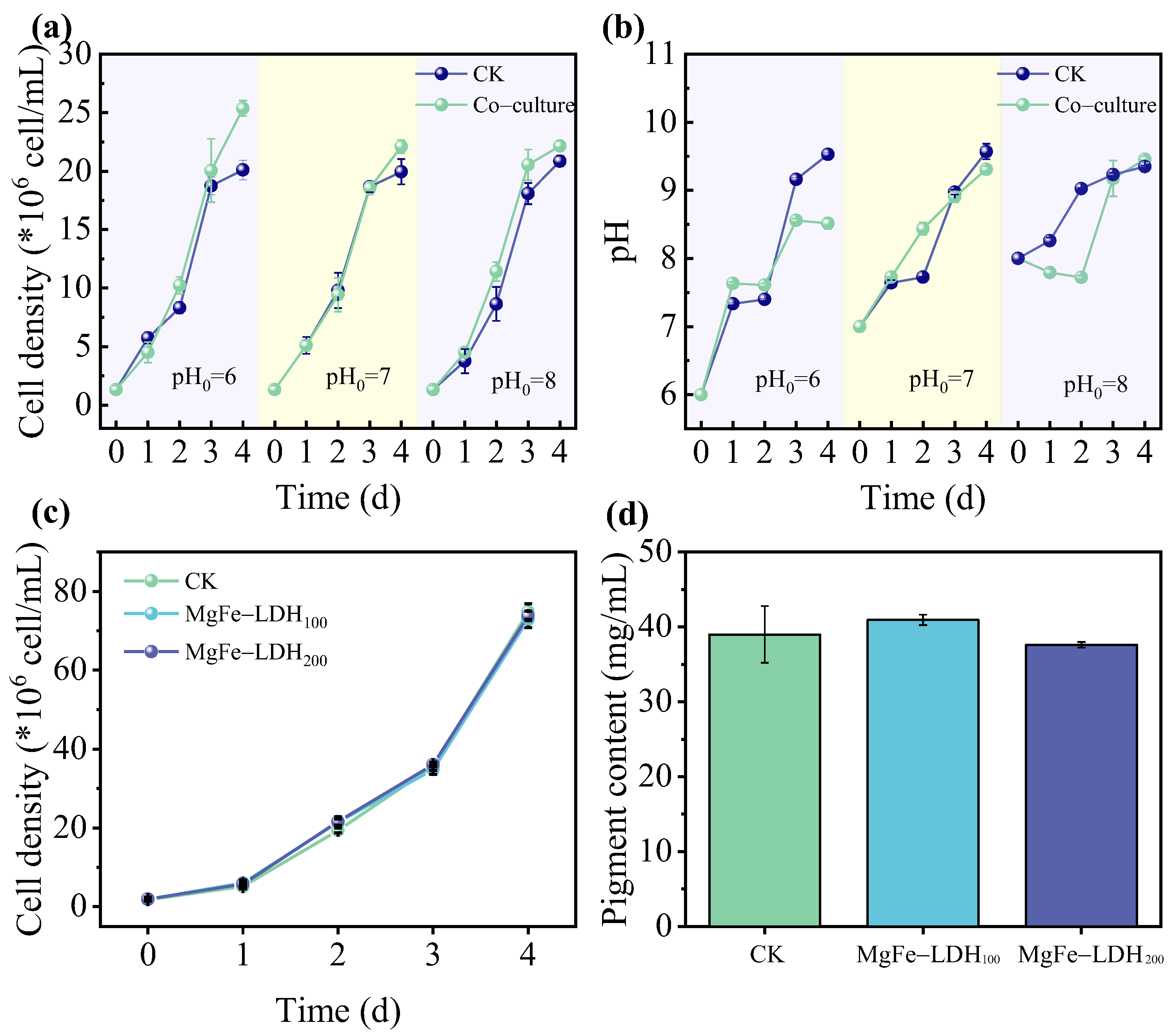
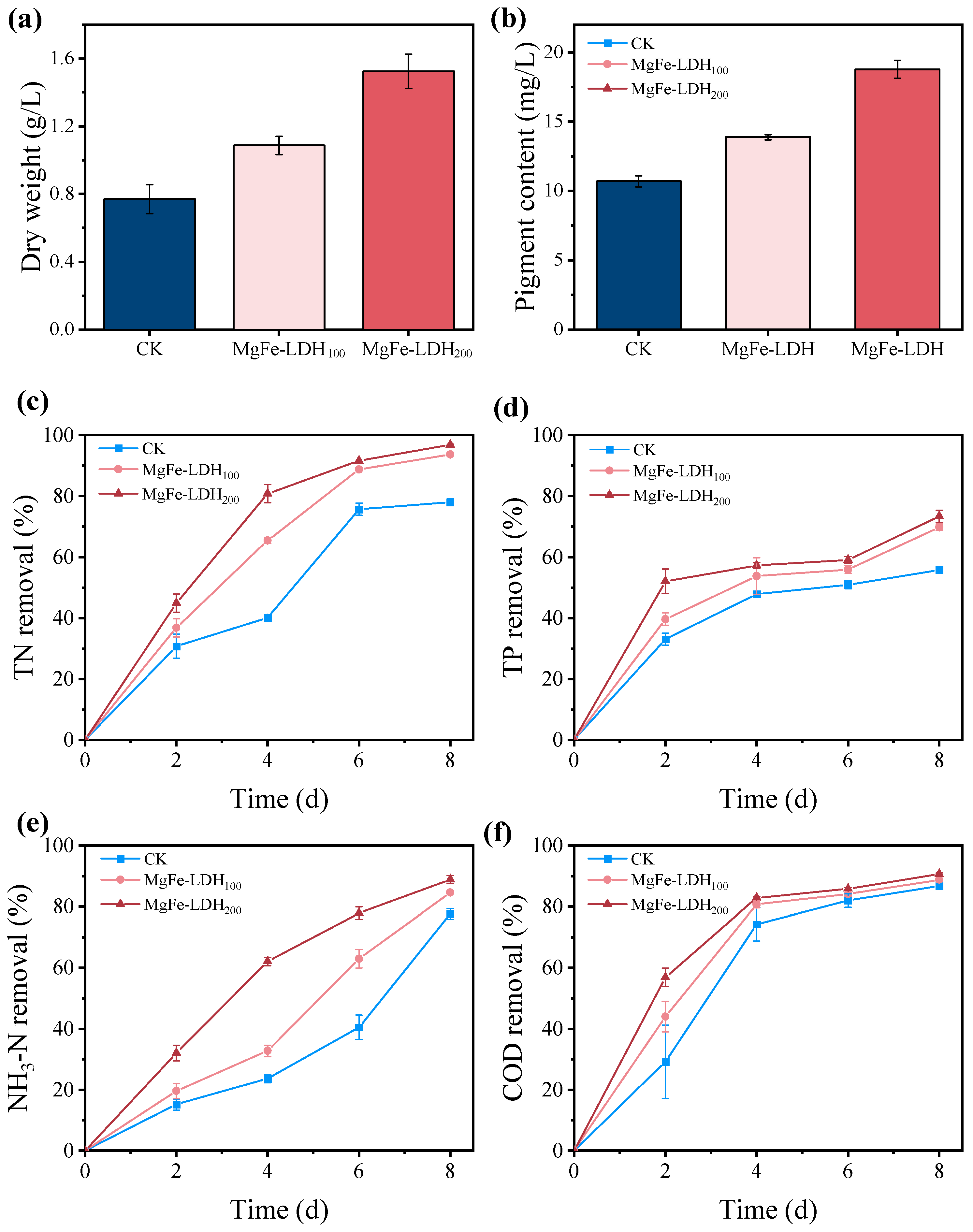
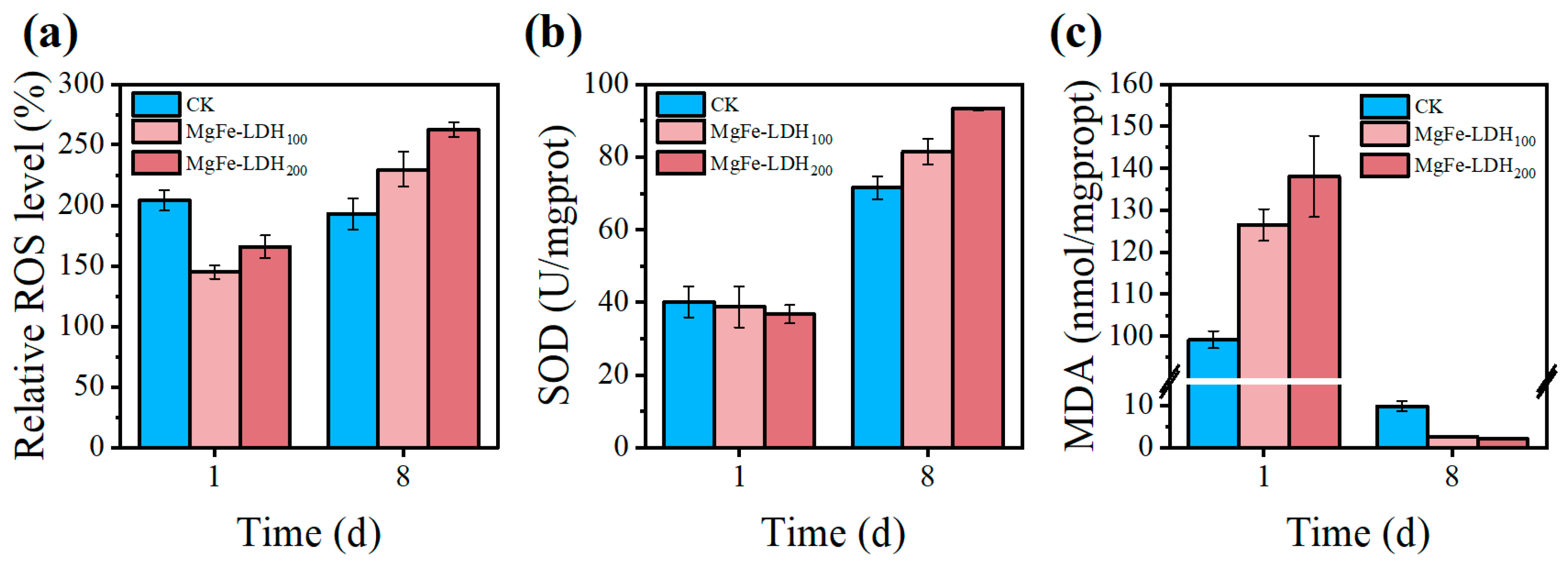
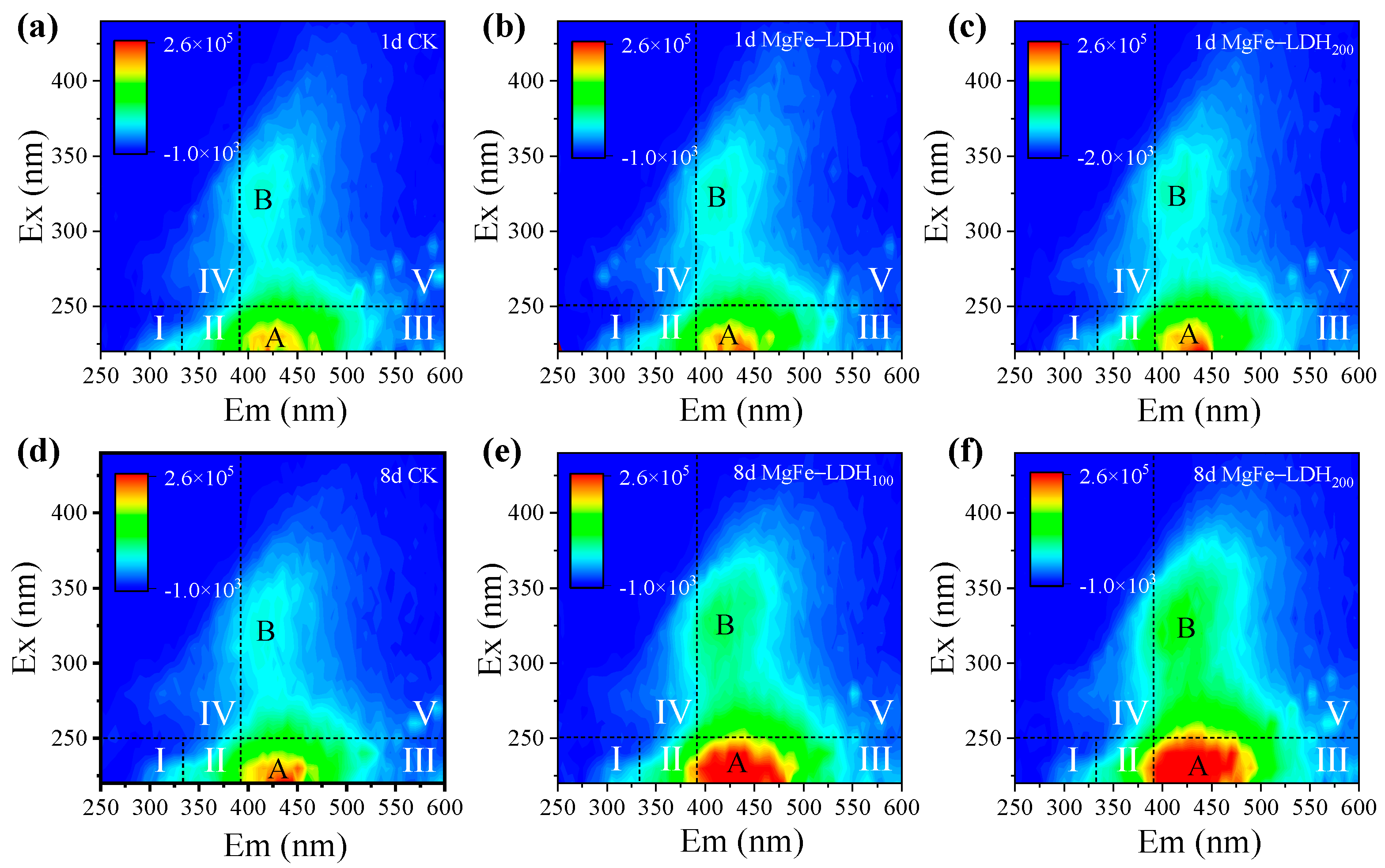
Disclaimer/Publisher’s Note: The statements, opinions and data contained in all publications are solely those of the individual author(s) and contributor(s) and not of MDPI and/or the editor(s). MDPI and/or the editor(s) disclaim responsibility for any injury to people or property resulting from any ideas, methods, instructions or products referred to in the content. |
© 2025 by the authors. Licensee MDPI, Basel, Switzerland. This article is an open access article distributed under the terms and conditions of the Creative Commons Attribution (CC BY) license (https://creativecommons.org/licenses/by/4.0/).
Share and Cite
Xu, H.; Zhou, H.; Hua, Y.; Chen, W.; Wu, J.; Long, Z.; Zhao, L.; Wang, L.; Shen, G.; Chen, Q. Enhancing CO2 Fixation and Wastewater Treatment Performance by Assembling MgFe-LDH on Chlorella pyrenoidosa. Sustainability 2025, 17, 8970. https://doi.org/10.3390/su17208970
Xu H, Zhou H, Hua Y, Chen W, Wu J, Long Z, Zhao L, Wang L, Shen G, Chen Q. Enhancing CO2 Fixation and Wastewater Treatment Performance by Assembling MgFe-LDH on Chlorella pyrenoidosa. Sustainability. 2025; 17(20):8970. https://doi.org/10.3390/su17208970
Chicago/Turabian StyleXu, Huanan, Hao Zhou, Yinfeng Hua, Weihua Chen, Jian Wu, Zhenwu Long, Liang Zhao, Lumei Wang, Guoqing Shen, and Qincheng Chen. 2025. "Enhancing CO2 Fixation and Wastewater Treatment Performance by Assembling MgFe-LDH on Chlorella pyrenoidosa" Sustainability 17, no. 20: 8970. https://doi.org/10.3390/su17208970
APA StyleXu, H., Zhou, H., Hua, Y., Chen, W., Wu, J., Long, Z., Zhao, L., Wang, L., Shen, G., & Chen, Q. (2025). Enhancing CO2 Fixation and Wastewater Treatment Performance by Assembling MgFe-LDH on Chlorella pyrenoidosa. Sustainability, 17(20), 8970. https://doi.org/10.3390/su17208970





